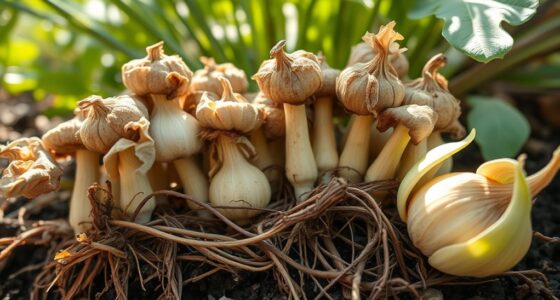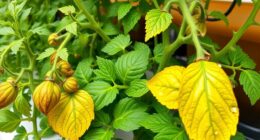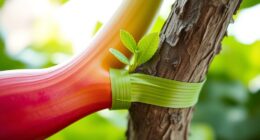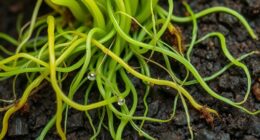Wild African violets, like Streptocarpus ionanthus, face threats from habitat destruction caused by human expansion into forests and grasslands. Climate change brings unpredictable weather that stresses their delicate environments. Invasive species compete for resources and spread diseases, while illegal collection reduces wild populations. Without proper conservation, these plants risk disappearing. To understand how these factors combine to endanger wild violets and what can be done, explore further insights below.
Key Takeaways
- Habitat destruction from agriculture and urbanization reduces available spaces for wild Streptocarpus ionanthus.
- Climate change causes temperature and rainfall fluctuations, threatening plant reproduction and survival.
- Invasive species outcompete native violets and introduce diseases, destabilizing ecosystems.
- Illegal collection and trade diminish wild populations and threaten genetic diversity.
- Conservation efforts are vital to protect habitats, control invasive species, and prevent overharvesting.
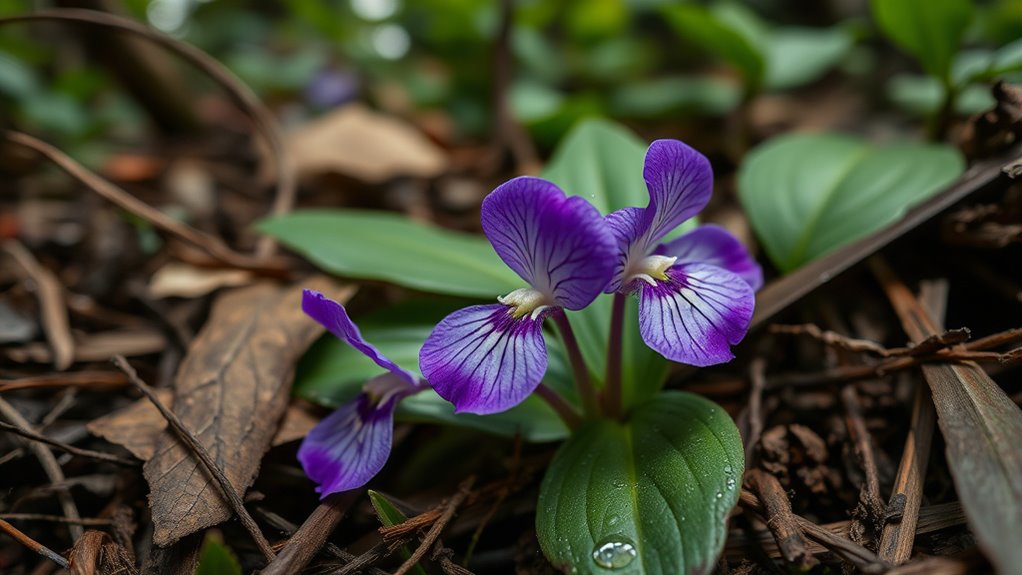
Wild African violets, cherished for their vibrant blooms and lush foliage, are increasingly threatened in their natural habitats. As you observe these delicate plants in the wild, you might not realize how fragile their existence truly is. Their survival depends on a narrow range of environmental conditions, which are rapidly changing due to human activity and climate shifts. You can help understand that every loss of wild populations diminishes the planet’s botanical diversity and weakens the ecological balance they support.
One of the main threats facing Streptocarpus ionanthus is habitat destruction. As human populations expand, forests and grasslands where these violets thrive are cleared for agriculture, urban development, and infrastructure projects. You might see this happening around you—forests cut down, land scraped bare—and realize that these areas often contain many unseen species. When their habitats are destroyed, the violets lose their native soil, shade, and moisture regulation, making it difficult for them to survive or reproduce. This rapid habitat loss leaves these plants with fewer places to grow and less opportunity to adapt to changing conditions.
Habitat destruction from development threatens wild African violets’ survival and diversity.
Climate change also poses a significant risk. Rising temperatures, irregular rainfall patterns, and more frequent extreme weather events are altering the microclimates where wild African violets flourish. You might notice increased drought periods or unseasonal storms, which can dry out or flood their habitats. These fluctuations challenge the plants’ ability to reproduce and sustain healthy populations. Since Streptocarpus ionanthus is adapted to specific environmental niches, even slight changes can have outsized effects, pushing their populations toward decline. Additionally, the importance of color accuracy in their ecosystems highlights how sensitive these plants are to environmental quality.
Another concern is invasive species. When non-native plants or animals enter their ecosystems, they can outcompete native violets for resources or introduce diseases. You might not see these invaders directly, but their impact can be profound, leading to reduced seed dispersal, limited genetic diversity, and increased vulnerability to pests and pathogens. Invasive species often thrive in disturbed areas, further exacerbating the threats faced by wild African violets.
Lastly, illegal collection and trading of these plants for horticultural or ornamental purposes threaten their wild populations. As demand for rare and exotic plants grows, poachers may harvest violets directly from their native environments, often without regard for sustainability. This unsustainable harvesting can wipe out entire populations, especially when combined with habitat loss and climate challenges.
Understanding these threats emphasizes the importance of conservation efforts. Protecting wild African violets requires a combined approach—preserving their natural habitats, combating climate change, controlling invasive species, and regulating plant collection. By doing your part to raise awareness and support conservation initiatives, you contribute to safeguarding these beautiful plants for future generations.
Frequently Asked Questions
Are Wild African Violets Suitable for Indoor Cultivation Worldwide?
Yes, wild African violets, or Streptocarpus ionanthus, are suitable for indoor cultivation worldwide. You can grow them successfully indoors by providing bright, indirect light, maintaining consistent moisture, and ensuring good air circulation. They thrive in well-draining soil and prefer moderate temperatures. With proper care, you’ll enjoy their vibrant blooms year-round, making them a perfect addition to your indoor garden wherever you are.
What Historical Uses Do Local Communities Have for Streptocarpus Ionanthus?
You might be surprised to learn that local communities historically used Streptocarpus ionanthus for medicinal purposes, believing it could treat ailments like stomach issues and skin conditions. They also valued its vibrant flowers for decorative and cultural ceremonies, often incorporating it into rituals. Remarkably, these plants played a crucial role in traditional practices, showcasing their significance beyond just ornamental use, connecting communities to their natural environment and heritage.
How Do Climate Change Effects Specifically Impact Their Natural Habitats?
Climate change directly impacts their natural habitats by increasing temperatures and altering rainfall patterns, which can lead to habitat loss. You might notice their environments becoming more arid or flooding more frequently, disrupting growth conditions. These changes threaten the plants’ survival, forcing them to adapt or face decline. By understanding these impacts, you can better support conservation efforts to protect their delicate ecosystems from irreversible damage.
Are There Any Conservation Programs Actively Protecting Wild African Violets?
Yes, there are conservation programs working to protect wild African violets. You can support organizations that focus on habitat preservation, like local botanical gardens and international plant conservation groups. These programs often involve habitat restoration, seed banking, and raising awareness. By participating or donating, you help guarantee these beautiful plants survive for future generations. Your involvement makes a real difference in safeguarding their natural habitats against ongoing threats.
Can Cultivated Varieties Help Restore Wild Populations Effectively?
Cultivated varieties can be a crucial tool, like a bridge, helping restore wild populations. They serve as genetic reservoirs, preserving traits that might be lost in the wild. By carefully introducing these cultivated plants into native habitats, you support genetic diversity and bolster natural resilience. However, you should make certain that these efforts maintain ecological balance, avoiding unintended consequences that could threaten the very wild populations you’re aiming to protect.
Conclusion
Don’t delay—dive into protecting these precious plants before they’re permanently lost. By understanding the threats targeting Streptocarpus ionanthus, you can help stem the severity of their decline. Every effort counts, from spreading awareness to supporting conservation initiatives. Together, we can combat the creeping crisis and conserve these enthralling, colorful creatures of the wild. Act now, and ensure these beautiful blooms don’t fade into forgotten folklore forever.


